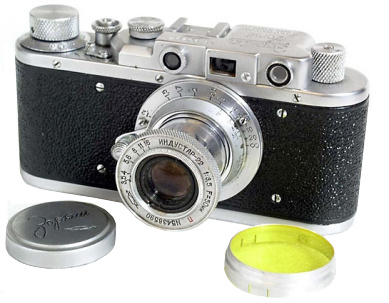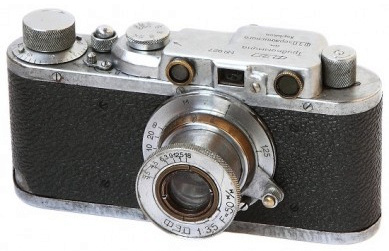
Cameras
The inventory shows 4 cameras, but based on known films and photographs there were at least 5. We have the negatives of 6 films: 4 films were still inside the cameras, and 2 more rolls were found in the tent. There are loose photos that do not belong to any of these 6 films. Some of them were developed by Bienko, the student that did not go and Zolotaryov filled on his place in the group.
In 2009 researchers Aleksey Koskin and Yuri Kuntsevich gained access to the archives of the late lead investigator Ivanov. The numbering of the films is taken from Koskin's photo archive.
- Film №1 - 34 photos, belongs to Georgiy Krivonischenko (found inside "Zorkiy" №488797)
- Film №2 - 33 photos, belongs to Igor Dyatlov (only the last one is from the trek)
- Film №3 - 17 photos, photographer unknown (most likely Thibault-Brignolle)
- Film №4 - 27 photos, belongs to Rustem Slobodin (found inside "Zorkiy" №486963)
- Film №5 - 24 photos, photographer unknown
- Film №6 - 36 photos, of which only 28 relate to this trip. This film precedes Film №1 (to be exact, it should be numbered №0 since it ends where Film №1 begins). The film has been misplaced after the photos were developed.
- Loose photos - 8 photos that are taken during the trip but are not part of the other films.
- Damaged film from the camera found on Zolotoryov's body.
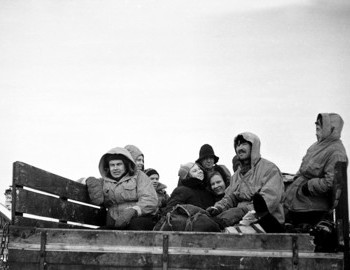 Krivonischenko camera (70)
Krivonischenko camera (70)
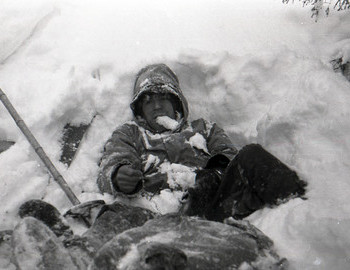 Thibeaux-Brignolle camera (17)
Thibeaux-Brignolle camera (17)
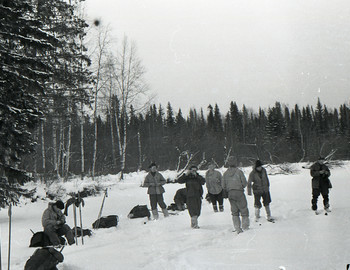 Slobodin camera (27)
Slobodin camera (27)
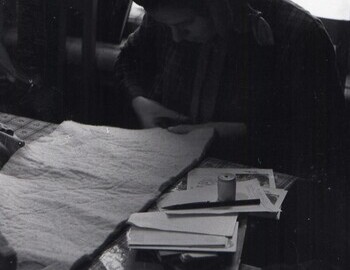 Dyatlov camera (33)
Dyatlov camera (33)
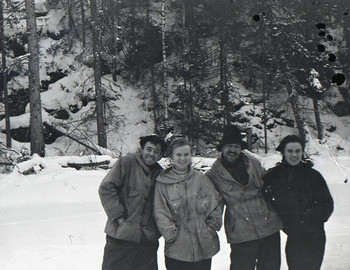 Unknown camera (24)
Unknown camera (24)
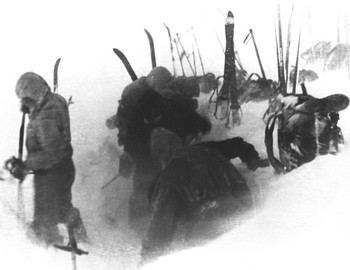 Loose photos (12)
Loose photos (12)
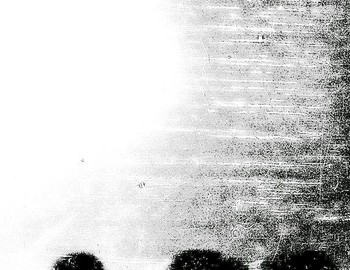 Zolotaryov camera (11)
Zolotaryov camera (11)
Initial inventory by the prosecutor Tempalov written on 27-28 February 1959 mentioned only 3 cameras. In March was introduced one more camera (keep reading *). They belonged to Dyatlov, Zolotaryov, Krivonischenko and Slobodin. Cameras were identified with their their serial numbers and number of frames of the films found inside. The photos were brought to a public domain much later, so we need to deduce which film was taken from which camera and who made the photos.
In camera №488797 belonging to Krivonischenko (with broken light filter) was found film with 34 frames. This film corresponds to film №1 - 33 photos plus one damaged frame in the middle. Cameras belonging to Zolotaryov №55149239 and Slobodin №486963 are found with films with same number of frames 27. In Koskin's photo archive there are two films with 27 photos - numbered 2 and 4. We need to deduce by looking through the photos which film was shot by whom. This photo proves that film №4 was shot by Slobodin.
* There is no information how many photos were taken with Dyatlov's camera №55242643. This camera was introduced in the inventory of the case in March 1959 due to the fact that the camera was taken from the tent by one of the students volunteering in the first search party. He developed the film with the intend to do some private investigation into the matter till he was asked by the official investigators to hand over the camera and the film which he did (controversy). By deduction none of the films in Koskin's photo archive belongs to Dyatlov's camera. Here are photos of each film in this list showing Dyatlov caught on film without him knowing that he is being photographed: film №6, film №1, film №3, film №4, film №5.
So far we have 4 cameras and at least 6 films which means some of the films were taken out and replaced with new. Film №6 starts with photos that are not from this trip, then follow 28 photos that are from the trip and the last frame is almost identical with the first photo from film №1. Film №6 precedes Film №1. Film №3 can not be shot by any of the cameras that are listed so far. Same applies to Film №5. Cameras are most certainly more than 4. One additional camera was found on Zolotaryov's body.
Summary of the conclusions we can make by paying a closer look at the photos that tell us a lot about the dynamics in the group:
- The group "core" consisted of Dyatlov, Slobodina, Thibeaux-Brignolle and Krivonischenko. They were on the most of the photos and were photographing each other. They are all graduates from Ural Polytechnic Institute. They knew each other very well, they friendship was based on trust and genuine sympathy.
- Zolotaryov was well accepted and integrated in the group, and that his age and background didn't set him apart or bring tension. Zolotaryov became а part of the core.
- In the periphery of the group belonged Kolevatov, Krivonischenko, Doroshenko, Kolmogorova and Dubinina. Yuri Yudin (the tent member of the group that turned around due to illness thus remaining alive) was also in the periphery.
- The fact that women were not in the "core" eliminates the "female factor" as a premise for a conflict between the group members. Presence of girls and women in a group with a predominance of men in terms of victimology can serve as a serious destabilizing factor, the competition between men for women's attention or struggle between women for influence on men. To run a conflict chain a woman or girl should be in the dominant nucleus. If the girls are in the periphery neither the struggle for the sympathy of girls, nor their game of "favoritism" could destroy the integrity of the group simply because the "core" wouldn't allow it. There is no doubt that the presence of girls in the group was not a source of tension and did not cause internal conflicts.
- Analysis of the hiking photos submitted by Alexei Vladimirovich Koskin, suggests that the number of cameras carried by the hikers exceeded the number said in the investigation. The crime case inventory lists Krivonischenko, Zolotaryov (contains film with photos before the hike started), Slobodin and Dyatlov. We know that Thibeaux-Brignolle shot a film (camera not found), which makes 5 cameras, and film №5 belongs to unidentified camera 6. Studying the films and evidence we come to a very strange conclusion: Semyon Zolotaryev had two cameras - one found in the tent, and a second was carried with him in the ravine. No information can be found about this camera or the film inside. Could the camera belong to Thibeaux-Brignolle? There is no sense Thibeaux-Brignolle handing his camera to Zolotaryev while alive. He had the same chances of survival (they were both fairly well dressed), and even if Thibeaux-Brignolle died first his gloves and sheepskin jacket would have been more important for Zolotaryov than his camera. The fact no clothes were taken from Thibeaux-Brignolle says that he was one of the last to die. We can make the assumption that the camera found on Zolotaryov's body does not belong to Thibeaux-Brignolle.
- With all said above we think there are at least two unaccounted cameras in addition to the 4 cameras from the crime inventory and the camera found on Zolotaryov's body. The cameras found in the tent were Zorkiy (left photo). Missing cameras - one attributed to Thibeaux-Brignolle, and one more that could be Zina's are both lower price range cameras - FED (right photo). Zorkiy costs at the time 370 rubles, FED costs 270. Zorkiy has newer model lens Industar-22 with more advanced optics, FED has Industar-20 lens. Although the size, shape and general outlook of both cameras are similar, one could very easily distinguish one from the other first because the new Industar-22 lens had different light reflectance and seemed visibly darker, and secondly by the marking at the front of the lens. Zorkiy has a light filter like the one on Krivonischenko's camera. That is the other strange detail - the light filter has its own protective case and to brake the filter one has to either stomp on top or take it put and brake it. The filter was found cracked inside its protective case.
- Besides the broken light filter and missing cameras, there are other circumstantial evidence suggesting that somebody besides the hikers was inside the tent - short horizontal cuts from inside the tent overlooking the slope where the footsteps were found, a ski pole clipped and not used (as if prepared to prop the sagging tent - the hikers wouldn't destroy their ski pole to do that), scattered crackers, and there are more...

